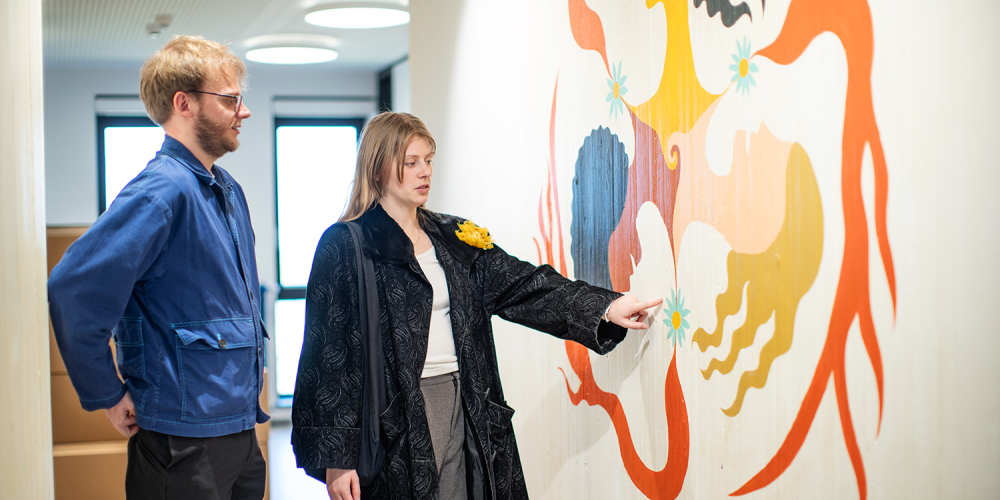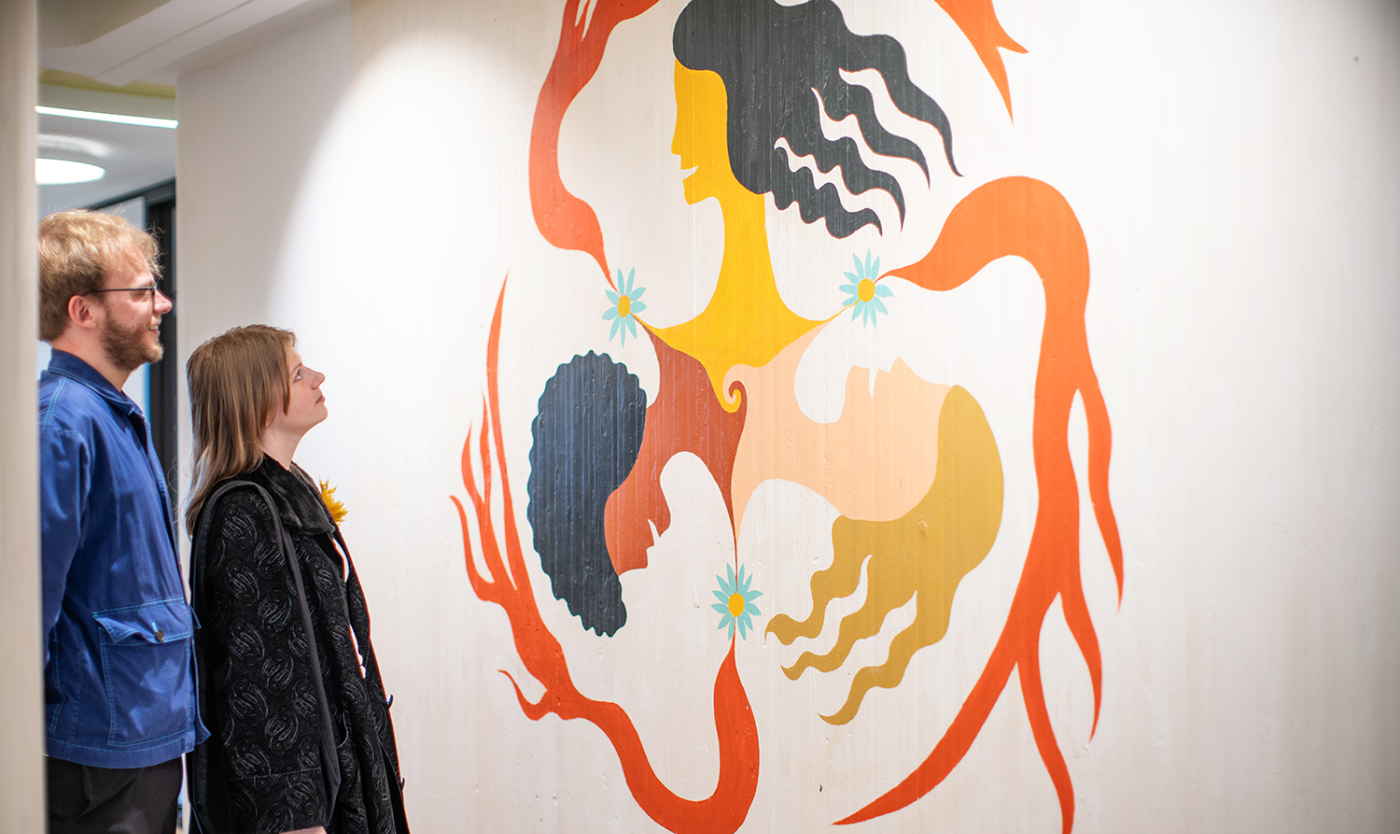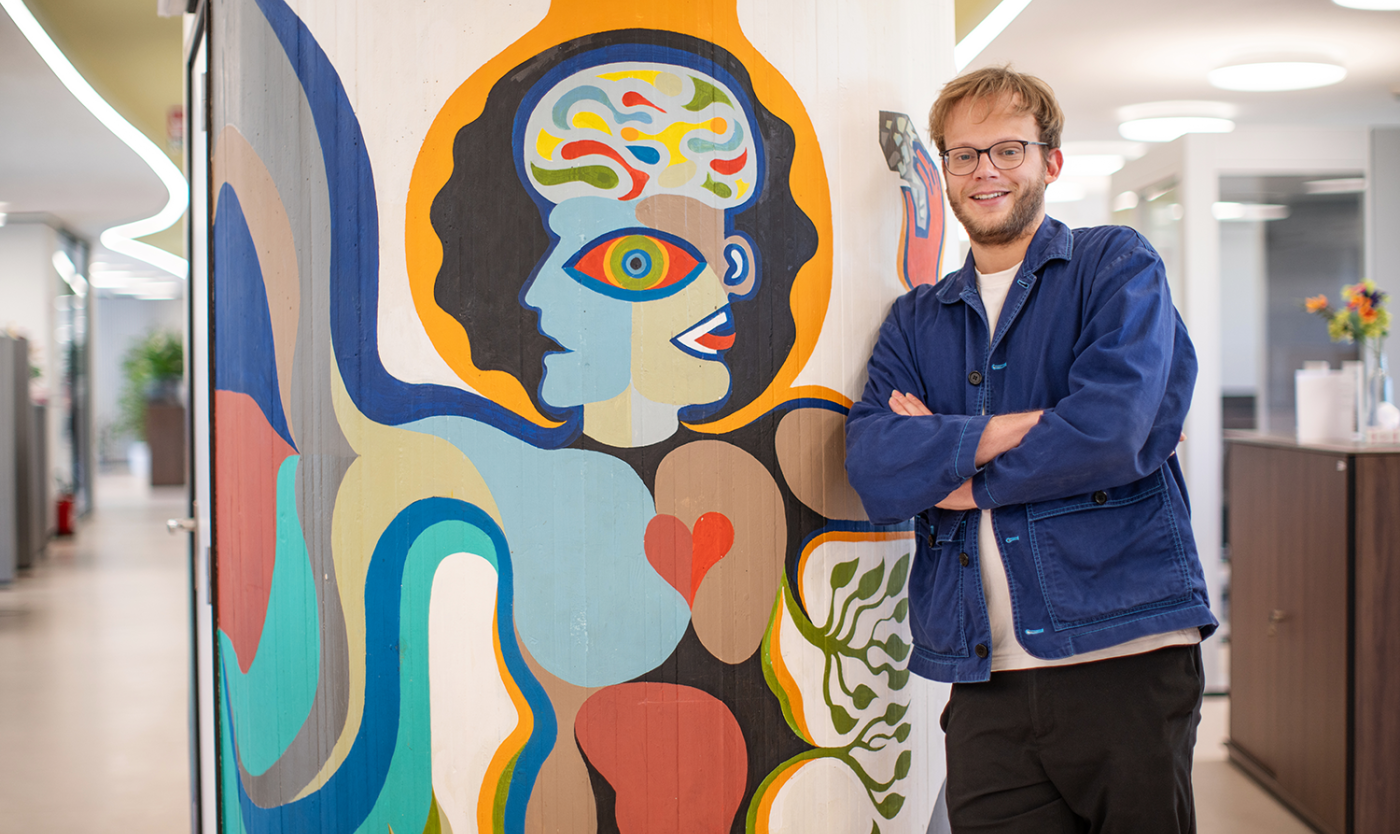
From 24 to 26 April, Ode to Wonder (Ode aan de verwondering) will premiere at NTGent – a monologue inspired by the book of the same name by our late rector Caroline Pauwels. The script was written by Dimitri Leue, with An Miller in the lead role. Caroline's children are closely involved in the project. Her son Emil is supporting on the production side, while daughter Anna Violette created the scenography, drawing architectural inspiration from the iconic Braem building. VUB Today arranged a tour for Emil and Anna Violette at the place where they had once been a regular and familiar presence.
The Braem building must hold many memories for you. What was it like to revisit it?
Anna Violette Rousseau: “We used to visit mum here often, usually in a bit of a rush. At home, we’d hear all the passionate stories about the building and the architect. It had been a while since I’d been back, and I really enjoyed hearing and feeling that enthusiasm again.”
Emil Rousseau: “I saw it through a slightly different lens. I’ve recently started working part-time at VUB, right opposite the Braem building, so I see it almost every day now. But the rectorate floor – I hadn’t been there in years. I remember we’d usually pick mum up late in the evening – she always worked long hours – and from that floor we’d look out at the old Beobank building and wonder who that one light still burning belonged to. But really, a building is nothing without the people who bring it to life. It was heart-warming to see some of those familiar faces again.”
Anna Violette: “That’s true – we were mostly here in the evenings as kids. I remember the quiet atmosphere, just a few lights on. But today we visited in full daylight, under the sun. The building feels brighter now too, thanks to the recent renovation. I imagine it must be a lovely place to work these days.”
"A building is nothing without its people – it was lovely to see the ones who still bring it to life"

The rector’s office is on the top floor and features some unique wall drawings. One of them was your mum’s favourite, right?
Emil: “That’s right. It’s a painting of three swirling female heads – white, Black and Asian – with a kind of spiral in the centre. It was painted by the architect himself.”
Anna Violette: “It’s a bit of a stereotypical image, but it does show different cultures coming together. And it also marks the presence of women on the highest floor of the Braem building. I think it was mainly the message behind it that mattered to mum – the idea that everyone, regardless of gender or background, should have the chance to contribute to something meaningful at the university.”
Emil: “Universities – and let’s be honest, many institutions of power in our society – still have mostly men in top positions. I can imagine that this image, hanging on a floor where portraits of male rectors line the walls, carried special meaning for mum.”
Anna Violette, you’re studying architecture. What’s your take on this iconic building?
Anna Violette: “On paper, the rector’s building is the ‘most powerful’ one on a university campus, so you’d expect it to look quite dominant. But it’s the opposite. The Braem building has soft, flowing lines. The colours are light. All the drawings – made by Braem himself – show a care for both men and women. It’s close to professors, but also to students and all the people who keep the university going. Yes, the fourth floor does have some intense drawings about conflict and war, but overall, it feels like a gentle place to be.
What I enjoy most is looking at the details – the elements that make a building unique or add a playful touch. Like the three little umbrellas at the entrance. They’re a nod to the ‘umbrella mentality’ in administration, which also slowed down the building’s realisation. The building reads like a book. Each floor is a new page, a different story. It’s a great reminder of how fascinating Braem’s mind must have been.”
What stuck with you after the tour?
Emil: “I learned that the architect came here himself to finish the wall paintings – for ten years straight. Despite all the red tape and budget struggles, he kept going, stubborn and dedicated. Mum would’ve loved that. I’m pretty sure she would’ve considered Braem a kindred spirit and given him full credit.”
Anna Violette: “I feel the same way. And what stood out to me is how the building brings together art, science and culture. The brick façade, for instance – that’s very Belgian. That mix makes it a beautiful and remarkable space to me.”

Anna Violette
The Braem building also features in the scenography of Ode to Wonder, which premieres this month. A logical choice?
Anna Violette: “It actually wasn’t our first idea. At first, we thought about water – about a form that flows. That became a drop, then a circle, then an ellipse. When we really started considering the ellipse, the Braem building came into view. I started searching online for Braem’s original plans, and that’s how we moved from a generic ellipse to the actual dimensions of the Braem building – just scaled down.”
“I hope we’ll keep noticing the cracks of the day”
In the performance, your mother invites us to see the world again with the wide-open eyes of a child. In turbulent times like these, that’s not easy. What still inspires or amazes you?
Emil: “What we got most from the book was our mum – more than the text itself. But of course, parts of it were part of our upbringing. Like the idea that you can choose how to look at the world – with wonder, rather than with indifference. We learned that anything can be a source of wonder. Anything can spark a thought, an idea, a new action. I really hope we keep noticing those ‘cracks of the day’.
Wonder isn’t passive. It’s a thread to build around. You can live in the most beautiful palace in the world and still not realise how lucky you are. Beauty only exists once you’re able to name something as beautiful. That mindset – staying connected to beauty – meant everything to mum.”

Emil
Anna Violette: “I think it’s really hard right now to see the beauty in things, with everything that’s going on in the world. Mum helped me find a way to place all that heaviness. Now that she’s gone, I have to find that strength myself. But her energy is still very present. That’s why I find the Caroline Pauwels Emergency Fund so important – it helps students who are struggling get equal opportunities at VUB. Mum believed deeply in connecting wonder to science, and in giving everyone the chance to discover it. Keeping the door to wonder open for everyone – that was something she truly cared about.”
Emil: “I’m really glad that there are things happening now that she helped set in motion. I’m sure she would’ve loved the play – though probably after saying, ‘oh come on, you really didn’t have to do all this.’ (laughs) And I think about the school in Molenbeek, the Caroline Pauwels Atheneum, that will be named after her. She cared so deeply about students. I think she would’ve considered that an enormous honour.”*
VUB is hosting the performance on 3 December 2025 at the KVS in Brussels, and again on 5 March 2026 at the Stadsschouwburg in Mechelen, in collaboration with the Hannah Arendt Institute. Tickets will be available soon via Public programme | Vrije Universiteit Brussel.*
*This is a machine translation. We apologise for any inaccuracies.